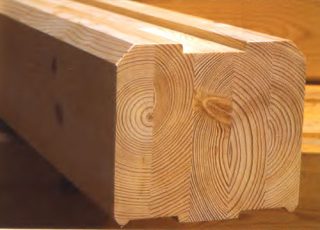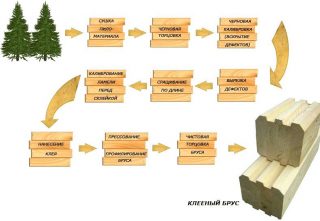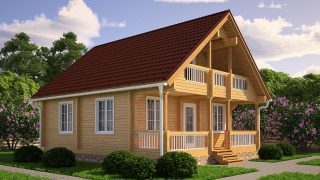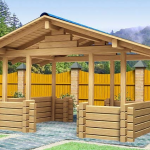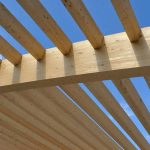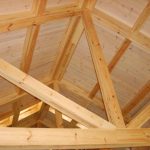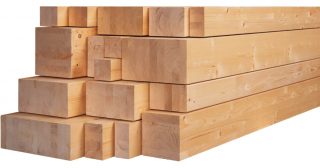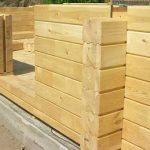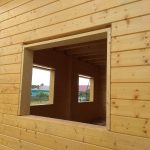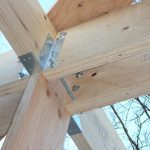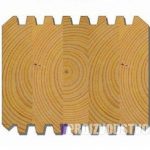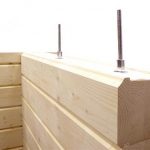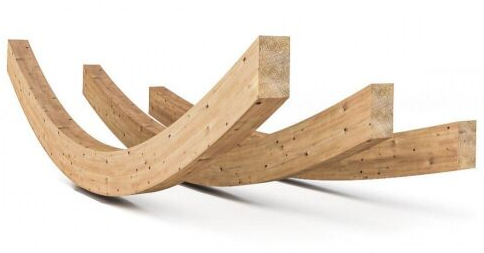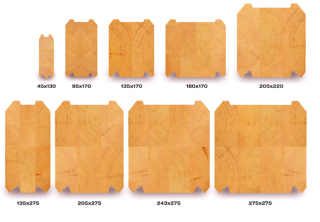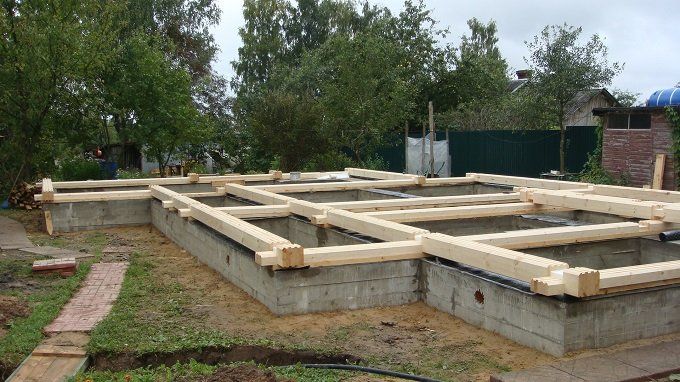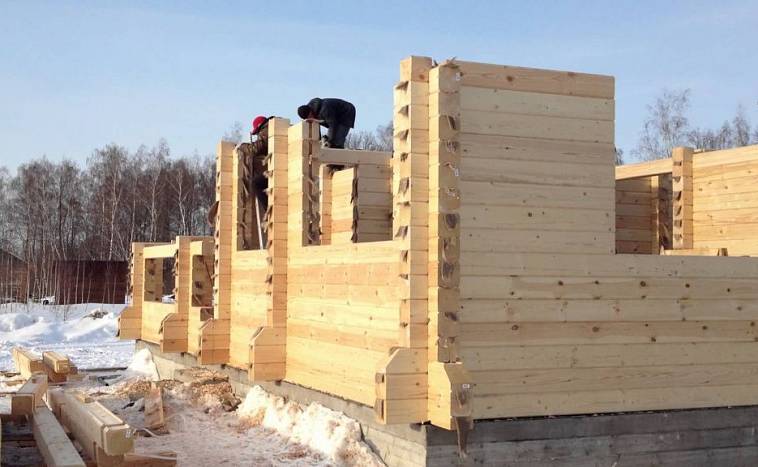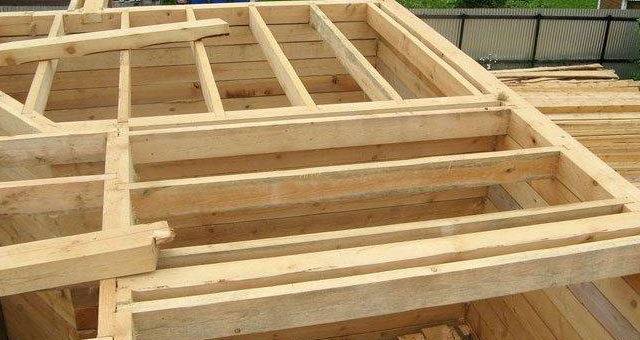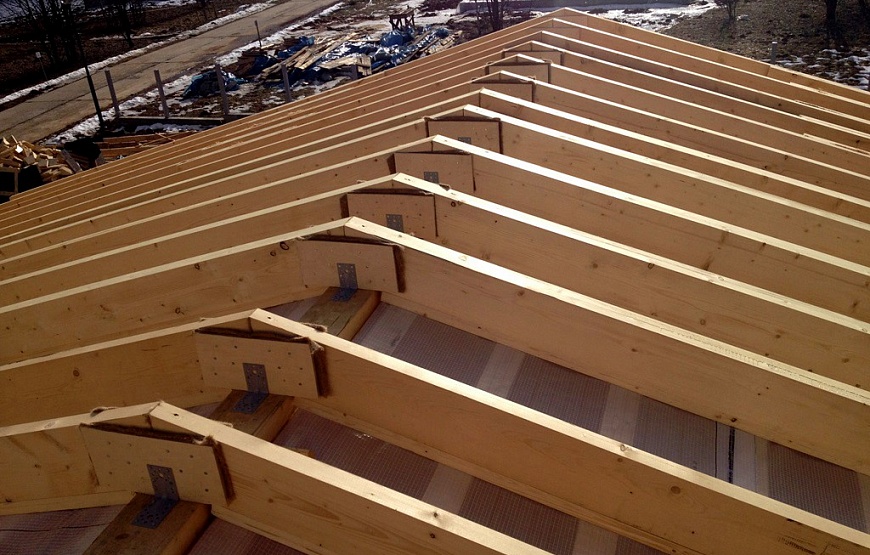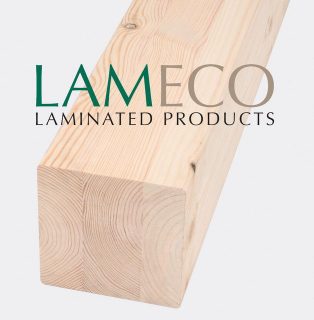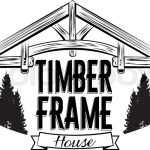Timber is a versatile material for construction. It is used as a base for load-bearing structures and as a material for masonry walls. Several varieties of such lumber are produced. One of the most interesting options is glued laminated timber.
- Description of material and production
- Scope of application
- Varieties of laminated veneer lumber
- Profile
- Construction type
- How to choose glued laminated timber for building a house
- Why material can't be cheap
- What to look for when buying
- Construction technology
- How to avoid mistakes
- Do you need finishing or processing
- Storing timber
- Manufacturers rating
Description of material and production
Bars are required in certain sizes. Only in this case will they fulfill their functions. However, when the trunk is cut, part of the tree turns out to be of inadequate quality, for example, if internal rot is found, deep cracks, part becomes unusable during processing, etc. Remaining fragments and clippings cannot be used. Nevertheless, we can talk about first-class wood, which is unwise to throw away.
Thin, but sufficiently wide and long lamellas are cut from the high-class residues, and then glued together into a single whole. The resulting material looks like a beam of a certain size and is not inferior in strength to the version cut from the trunk.
- wood sawing and drying - only dry wood with a moisture level of no more than 15% is used for the manufacture of laminated veneer lumber;
- rough trimming and calibration - the lamellas must have absolutely exact and identical dimensions;
- cutting of defects - pockets, knots, chips are removed;
- splicing lamellas along the length;
- calibration of workpieces before gluing - very precise fit in size;
- glue application - two-component are more often used;
- pressing and profiling of a bar - under pressure the lumber takes the desired shape;
- finishing trimming.

In the glued laminated timber, the lamellas are positioned so that the direction of the fibers did not match... The material loses the ability to remove moisture, but at the same time it does not respond to changes in temperature and humidity and retains perfectly accurate dimensions and configuration. You can live in the house immediately after the completion of construction.
The benefits of using this material are so significant that they pay off the high cost and ensure its relevance.
Scope of application
- The material is used for construction of residential and public buildings of any type and kind.
- They are made of timber supporting frames for a gazebo, an extension, a garage.
- The splicing technology practically does not have any length restrictions. Therefore, you can get beams up to 36 m long.Such elements are used for span overlaps big size.
- Beams and racks are used in the construction superstructures over the restored 4- and 5-storey buildings... The metal frame will be too heavy, and ordinary timber will not cope with the loads.
- Glued material is used in the construction of critical units: beam connections in a building, bridge support structures.
It is recommended to use glued wood in the construction of structures in areas with strong gas pollution, as well as on the sea coast. The material withstands the action of dissolved salts well.
Varieties of laminated veneer lumber
By purpose, there are 3 categories.
- Stenovoi - up to 240 mm thick, designed for self-supporting walls. The number of grooves and protrusions at the ends is regulated by the manufacturer. The front side is usually smooth, but it can have a rounded shape. They produce a version without insulation and with insulation. Inside the latter, a recess is made for the masonry of the heat insulator, or they are immediately supplied with an additional heat-insulating layer.
- Window and door - for such a profile, take wood with a moisture content of no more than 12%. The properties of the window beam are regulated by GOST 30972-2002. For manufacturing, conifers are more often used, since they are more resistant to rot.
- Reference - beams and racks for supporting structures. Requirements for them are described in SNiP "Wooden structures". The material is used for the construction of interfloor floors, beam systems, frames, truss structures.
Profile
By the number and method of arrangement of spikes and grooves, they are distinguished The 3 most popular types.
- Comb - finely toothed. The grooves and protrusions are of the same shape, small, but cut in large quantities. The manufacturer claims that a small comb allows the elements to be joined as tightly as possible. On the one hand, this is true, but in damp areas such small teeth change the geometry. Often, in order to plant the bars on top of each other, you have to use a sledgehammer.
- Finnish - or Scandinavian. Assumes only 2 wide ridges located near the very edges and 2 corresponding grooves. The connection is extremely simple, but not too tight. It is recommended to use an inter-lead gasket here to avoid cold bridges.
- German - wide comb option. There are only 3-4 teeth, quite wide, like the grooves. The connection is tight, but does not require jamming, as is the case with a fine comb. However, in extreme cold or damp conditions, the same problems can arise.
With high wood moisture or inaccurate dimensions, any profile will give a poor connection.
Construction type
Glued laminated timber manufacturers offer 2 types of material.
- Standard - the bars can have different configurations, but they are always long, even elements. These are beams, racks, slats for laying walls, a window profile.
- Bent - bending and gluing thin lamellas is much easier and more convenient than a thick bar. Therefore, arched structures of various types, both supporting and window or door structures, are made of glued beams.
Only 1 type of wood is used for manufacturing. It is impossible to combine different breeds.
How to choose glued laminated timber for building a house
The load-bearing capacity depends on the thickness and height of the lumber... Choose it like this.
- For a light garage, shed or an extension to the house, it is enough to take a block with a section of 100 * 100 mm.
- For a summer house or summer cottage, a thicker timber is needed - 150 * 100 mm, 150 * 150 mm, but such a building can be used only in the warm season.
- For a house in which they live year-round, a timber is needed not only durable, but also warm, with a thickness of at least 200 mm.
- In the northern regions, the building is constructed from material up to 250 mm thick. The strength of such a bar is excessive, but thinner material is not suitable for keeping warm in the house.
It is worth paying attention to the type of wood, since the strength depends on the nature of the wood.
Why material can't be cheap
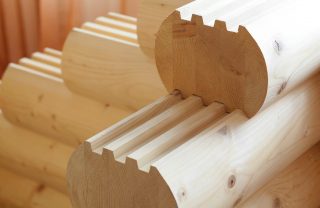
Glued laminated timber is an expensive material. Its production technology includes energy-consuming processes.
- Drying - chamber or natural. The first requires electricity, the second takes a lot of time. So both are expensive.
- Plural material calibration - are performed on special equipment, powerful enough.
- Form a bar under pressure, this requires special equipment.
For laminated veneer lumber they take, albeit unmeasured, but first-class material, but it is never cheap.
What to look for when buying
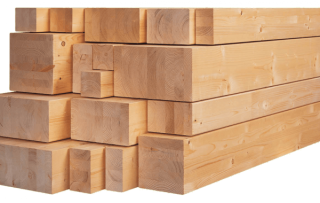
The popularity of the material has led to the appearance of counterfeits and low-quality products on the market. When buying lumber you need to pay attention to the following signs.
- Splice lengthwise - boards with a length of 120 cm are not used for high-quality material.
- Knots - light, healthy knots are even welcome, as this means that trees grown in the north were used for the production, and their wood is more resistant to mold. Dark knots, pockets indicate poor quality, since according to the technology, defects must be cut out before gluing the lamellas.
- Spike connections - the joints must be glued and sanded. If there are gaps in the joint, the material is of poor quality.
- Uniformity - a bar cannot be entirely of the same color, but it should not include the entire gamut of colors either.
Shallow cracks and chips at the ends of the bars are not a defect.
Construction technology
The general scheme of building a house from glued laminated timber is no different from the construction of another type of wood.
- Lay the foundation. The type and size of it depends on the area of the house and the nature of the soil. The more the latter is mobile, the deeper and heavier the foundation has to be built.
- After construction and waterproofing, a horizontal structure is laid on the foundation, which serves support for future capital and interior walls... The heaviest and thickest timber is used. At the same stage, they mount logs for the floor.
- Get out the walls. The bars are stacked on top of each other, connecting the elements in various ways - in the "bowl", "dovetail", on the "root thorn". Preference is given to wooden fasteners, without corners and nails.
- When the walls reach the required height, equip top harness from thick bars. It serves as a Mauerlat or as a base for an interfloor overlap.
- Are being erected rafter system... With a small area of the house, it is collected on the ground, then raised. If the roof is complex and large, the system is mounted at the top.
Since glued laminated timber does not shrink, you can immediately start finishing the building.
How to avoid mistakes
In order for the future house to serve for a long time, it is very necessary carefully design his. In this case, the following points are taken into account:
- heat storage requirements - if the owner does not want to additionally insulate the house, the thickness of the timber should be selected based on its heat-saving properties;
- building weight - if a pile foundation can be built under a frame house, then at least a strip base will be required for a two-story cottage;
- the corners when laying the timber are blown to one degree or another, therefore during construction it is necessary to use mezhventsovy sealant;
- although the timber does not shrink, metal-plastic windows or doors are installed only in the casing.
Finishing work, internal and external, can be started immediately after installing the roof.
Do you need finishing or processing
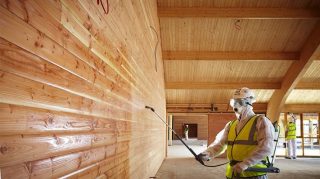
The surface of the material is even, smooth, the wood for the material is selected clean and beautiful. However, the tree, even with such processing needs protection.
It is undesirable to paint the walls: the paint masks the natural colors and the interesting woody pattern. More often timber treated with stains or varnished. Such processing can only slightly change the shade of the wood, but retains its texture.
Storing timber
- The lumber is stacked stacks under a canopy or in a shed... In the latter case, it must be ensured good ventilation.
- During rains or snowfalls, it is advisable cover the stacks with foil.
- Recommended cover the ends of the timber with linseed oilso that the wood does not dry out too much.
In winter, the timber is stored in the same conditions as in summer.
Manufacturers rating
- Lameco Lht Oy Is a Finnish company. Offers softwood beams of the highest quality and durability. It ranks first in the market.
- KONTIO Is a Finnish manufacturer offering arctic pine material. The timber is produced according to our own technology.
- Honka - a Finnish company produces timber and kits for housing construction. On the market for over 60 years.
- GK Priozersky Lesokombinat Is a Russian company. Produces material using Finnish technology.
- Timber Frame - another Finnish company offers profiled, glued beams and rounded logs using a unique technology. It attracts with a variety of standard sizes and profiles.

